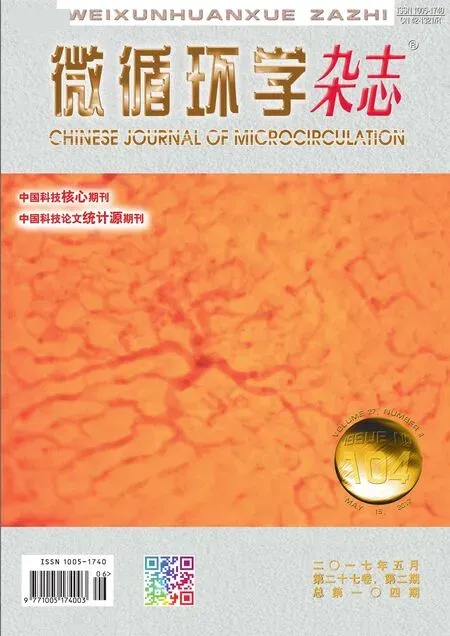血管内皮生长因子在骨关节炎软骨钙化层重构中的作用*
胡琼洁综述 周建林审校
血管内皮生长因子在骨关节炎软骨钙化层重构中的作用*
胡琼洁1综述 周建林2,#审校
骨关节炎(OA)是一种以关节软骨退变、滑膜炎、软骨下骨改变及骨赘形成为病变基础的疾病。研究发现血管内皮生长因子(VEGF)参与了OA的发生发展过程, 尤其是参与软骨钙化层重构;血清VEGF水平与关节炎严重程度密切相关。本文对此研究进展作一综述。
骨关节炎;血管内皮生长因子;钙化层
骨关节炎(Osteoarthritis, OA)是一种以关节软骨退变、滑膜炎、软骨下骨改变及骨赘形成为病变基础的疾病,主要表现为关节疼痛及活动受限,常危害中老年人身心健康。随着社会人口老龄化,OA的发生率逐年增加,但其发病原因目前不太清楚。不断探讨OA发病机制,从而更有效地防治OA,成为学界重要课题。现有研究发现,软骨钙化层在骨关节炎发生发展中起到一定作用,血清血管内皮生长因子(Vascular Endothelial Growth Factor,VEGF)水平与关节炎严重程度密切相关,表明VEGF可能参与了软骨钙化层重构,为深入探讨骨关节炎机制提供了新的路径和策略,具有重要的科学意义和社会价值。
1 OA的软骨钙化层变化
正常关节软骨和软骨下骨共同承载与分散来自重力及运动的负荷,OA则是正常关节承受不正常压力或不正常关节承受正常压力后发生软骨及软骨下骨病变。既往研究认为,关节软骨和软骨下骨相互独立[1];然而近年研究发现OA软骨与骨之间可能相互影响[2],非钙化层软骨细胞和骨细胞存在“对话”[3,4],其中OA软骨下骨的新生血管穿过钙化层,侵入非钙化层软骨,实现了“骨-软骨对话”,具有新的研究意义,但其机制仍不明确[5]。
正常膝关节的关节软骨钙化层厚度从几微米至300多微米不等,结构紧密,内含少量肥大软骨细胞;钙化层是骨与软骨之间的界面结构,与非钙化层以潮线(关节软骨发育成熟的一个重要标志)状紧密连接,通常为一条波浪状结构,含有扁平状和垂直状胶原。当软骨退变或发生骨性关节炎时,钙化层的矿化缘向未钙化软骨区推进,非钙化层变薄,出现“潮线漂移”[6,7]。既往有研究认为致密钙化层结构是骨软骨交通的障碍,阻止了小分子有机物质在骨-软骨之间流通,象隔离带一样将骨-软骨分割成两个独立的环境[1],形成“骨-软骨对话”的主要障碍。近年来越来越多的研究证实,钙化层并非是完全不可逾越的屏障,骨-软骨之间存在某些“对话”[2],Arkill 等[8]发现小分子示踪剂荧光素Na和玫瑰红B可以从上下两侧自由通过成年马掌指关节软骨钙化层;Guévremont 等[9]首次发现OA患者成骨细胞来源的人类生长因子(HGF)可能以旁分泌方式通过钙化层进入非钙化软骨深层;Pan等[10]报道骨-软骨界面通透性与OA严重程度呈正相关;Gupta等[11]认为早期钙化层不均一、矿化程度增加、钙化层增宽、潮线向软骨浅层推进、软骨变薄,使得非钙软骨层钙化,出现“潮线漂移”;而且钙化层Ⅹ型胶原表达下降、微裂隙形成、硬化区成骨细胞抑制软骨细胞蛋白聚糖表达、诱导基质金属蛋白酶-3(MMP-3)和MMP-13表达,加速软骨降解,最终引起钙化层细胞的组成及三维空间结构变化和细胞通透性增加,新生血管侵入钙化层[12],促进“骨-软骨会话”。
2 关节软骨抗血管特性
正常人关节软骨中无血管,关节软骨具有抗血管生成特性,如抗血管生成因子-1(Thrombospondin-1,TSP-1)、肌钙蛋白I(Troponin I,TnI)、软骨调节因子-I(Chondromodulin-I,ChM-I)等。TSP-1主要在软骨的移行区和深层表达,能够抑制内皮细胞增殖、诱导其凋亡,并阻止VEGF与VEGF受体2(VEGFR2)结合[13,14];TnI能够抑制管腔样结构形成; ChM-I在防止软骨血管生成中同样发挥重要作用,在OA软骨钙化区及软骨下骨区ChM-I表达下降有利于血管侵入。然而,在OA的关节软骨中,软骨细胞集聚,并有血管从软骨下骨向软骨侵入,突破潮线侵入钙化层。
3 VEGF在OA钙化层中的作用
最近,许多学者研究发现关节软骨中新生血管出现,即VEGF参与了OA的发生发展过程[15,16], 而且血清VEGF水平与OA严重程度密切正相关[17]。我们前期的实验研究[18]也发现,OA关节软骨中VEGF 及VEGFR-2 mRNA表达较正常软骨明显升高,有利于血管生成;VEGF通过其受体特异性作用于血管内皮细胞,促进血管内皮细胞增生,使新生血管形成,并穿越钙化层侵入表层。还有研究表明,VEGF能明显提高血管通透性,加速OA炎症的形成和发展;VEGF参与关节软骨结构的重塑[19],促进软骨细胞表达一氧化氮(NO)、白细胞介素-1β(IL-1β)和白细胞介素-6(IL-6), 肿瘤坏死因子-α(TNF-α)及MMPs,抑制MMP组织抑制因子(TIMPs)合成[20]。本文作者前期实验发现,VEGF可抑制关节炎软骨细胞Ⅱ型胶原和蛋白聚糖的表达[21],加速软骨降解,破坏软骨完整性,减弱抗血管特性,为血管的侵入创造条件。关节腔内注射VEGF能加速软骨钙化及骨硬化,导致OA[22],而静脉注射VEGF单克隆抗体可以明显抑制新生血管的生成,促进软骨缺损的修复及新生软骨与周边软骨的嵌合[23]。Nagai等[24]发现软骨缺损修复组织中有大量血管组织侵入,导致修复软骨的生物力学性能较差,而机体一旦获得抗血管特性的骨髓干细胞,则具有良好的修复软骨性能,使软骨具有较好的完整性,能够抵抗机械压力和炎性因子的侵入。在此过程中,钙化层肥大软骨细胞发挥着指挥者的作用,主动调节软骨内成骨过程,通过改变周围基质的性质与成分,指导软骨内成骨的矿化;通过表达印度刺猬因子(Indian Hedgehog,IHH),诱导毗邻的软骨膜细胞分化为成骨细胞,形成骨领;通过表达VEGF,诱导血管内皮细胞的侵入[25]。由此可见,VEGF在关节软骨钙化层重构、新生血管形成及侵入过程中发挥了重要作用,但是其具体机制需要进一步探讨。
4 VEGF表达的调控
对于VEGF表达升高的调控机制,既往研究认为其主要受缺氧诱导因子-1α(Hypoxia-Inducible Factor 1α,HIF-1α)调节,HIF-1α可在早期分化的软骨细胞表达,诱导软骨细胞再生、基质合成及细胞存活等。这种观点与VEGF的作用机制大相径庭。我们复习文献后认为,VEGF至少不完全受HIF-1α调控。最近研究发现,缺氧诱导因子-2α(Hypoxia-Inducible Factor-2α,HIF-2α)在人及大鼠OA软骨中表达明显升高。HIF-2α由EPAS1基因编码,主要在钙化层高分化的肥大软骨细胞表达,诱导软骨细胞凋亡[26];上调VEGF表达,可致软骨基质降解,促进新生血管形成并侵入软骨[27,28]。
HIF-2α可能成为治疗OA的靶标[29],关节腔内注射Ad-EPAS1可以促进膝关节OA的发生,诱导MMPs、带有血小板凝血酶敏感蛋白样模体的解整链蛋白金属蛋白酶-4(ADAMTS-4)、猪前列腺素G/H合酶2(PTGS2)等代谢因素表达升高;相反,EPAS1缺陷大鼠可以抵抗OA的发展[30]。研究证实炎性因子及机械压力都可以引起核转录因子-κB(NF-κB)表达。NF-κB作为HIF-2α的上游信号,可以诱导HIF-2α表达。即NF-κB/ HIF-2α/VEGF信号通路参与了软骨退变[29]。由此推断VEGF可能通过NF-κB/HIF-2α信号通路参与钙化层软骨的重构和新生血管形成,而且可以设想相对分子量较HGF小的VEGF有可能自由通过钙化层,引起钙化层重构,出现“潮线漂移”,为新生血管的侵入铺平道路,促进“骨-软骨对话”。我们已经发现HIF-2α和VEGF的表达与OA的严重程度成正相关[31]。
5 结语
OA的发生是一个非常复杂的过程,“骨-软骨对话”机制仍不明确,可能与钙化层重构、“潮线漂移”有关;NF-κB/HIF-2α/VEGF信号通路可能调控钙化层软骨基质的转换,引起钙化层重构,潮线前移,通透性增加,为血管侵入做好准备。NF-κB/HIF-2α信号通路介导的VEGF对内皮细胞增殖、迁移、新生血管的形成及穿越、钙化层侵入非钙化层软骨发挥主要作用,可能是“骨-软骨对话”机制之一。
◀
本文作者简介:
胡琼洁(1982-),女,汉族,博士,主治医师,研究方向:骨关节炎的放射诊断
1 Burr DB.Anatomy and physiology of the mineralized tissues:role in the pathogenesis of osteoarthrosis[J].Osteoarthritis Cartilage,2004,12(Suppl A):20-30.
2 Findlay DM, Atkins GJ.Osteoblast-chondrocyte interactions in osteoarthritis[J]. Curr Osteoporos Rep,2014,12(1):127-134.
3 Goldring SR. Alterations in periarticular bone and cross talk between subchondral bone and articular cartilage in osteoarthritis[J]. Ther Adv Musculoskelet Dis,2012,4(4):2 458-2 492.
4 Pan J, Wang B, Li W, et al. Elevated cross-talk between subchondral bone and cartilage in osteoarthritic joints[J]. Bone,2012, 51(2):212-217.
5 Yuan XL, Meng HY, Wang YC, et al. Bone-cartilage interface crosstalk in osteoarthritis: potential pathways and future therapeutic strategies[J]. Osteoarthritis Cartilage,2014,22(8):1 077-1 089.
6 Bonde HV,Talman ML,Kofoed H.The area of the tidemark in osteoarthritis. A three-dimensional stereological study in 21 patients[J]. APMIS,2005, 11(5):349-352.
7 Lyons TJ, Stoddart RW, McClure SF, et al.The tidemark of the chondro-osseous junction of the normal human knee joint[J].J Mol Histol,2005, 36(3):207-215.
8 Arkill KP, Winlove CP. Solute transport in the deep and calcified zones of articular cartilage[J]. Osteoarthritis Cartilage,2008, 16(6): 708-714.
9 Guévremont M, Martel-Pelletier J, Massicotte F, et al. Human adult chondrocytes express hepatocyte growth factor (HGF) isoforms but not HgF: potential implication of osteoblasts on the presence of HGF in cartilage[J]. J Bone Miner Res,2003, 18(6): 1 073-1 081.
10 Pan J, Wang B, Li W, et al. Elevated cross-talk between subchondral bone and cartilage in osteoarthritic joints[J]. Bone,2012,51(2):212-217.
11 Gupta HS, Schratter S, Tesch W, et al. Two different correlations between nanoindentation modulus and mineral content in the bonecartilage interface[J]. J Struct Biol,2005, 149(2): 138-148.
12 Goldring SR, Goldring MB. Changes in the osteochondral unit during osteoarthritis: structure, function and cartilage-bone crosstalk[J]. Nat Rev Rheumatol,2016,12(11):632-644
13 Chu LY, Ramakrishnan DP, Silverstein RL. Thrombospondin-1 modulates VEGF signaling via CD36 by recruiting SHP-1 to VEGFR2 complex in microvascular endothelial cells[J]. Blood,2013,122(10):1 822-1 832.
14 Nieminen T, Toivanen P, Rintanen N, et al. The impact of the receptor binding profiles of the vascular endothelial growth factors on their angiogenic features[J]. Biochim Biophys Acta,2014,1 840(1):454-463.
15 Walsh DA, McWilliams DF, Turley MJ, et al. Angiogenesis and nerve growth factor at the osteochondral junction in rheumatoid arthritis and osteoarthritis[J]. Rheumatology (Oxford),2010, 49(10):1 852-1 861.
16 Ballara S, Taylor PC, Reusch P, et al. Raised serum vascular endothelial growth factor levels are associated with destructive change in inflammatory arthritis[J]. Arthritis & Rheumatism,2001, 44(9):2 055-2 064.
17 Clavel G, Bessis N, Lemeiter D, et al. Angiogenesis markers (VEGF, soluble receptor of VEGF and angiopoietin-1) in very early arthritis and their association with inflammation and joint destruction[J]. Clin Immunol,2007, 124(2):158-164.
18 Zhou JL, Liu SQ, Qiu B, et al. Effects of hyaluronan on vascular endothelial growth factor and receptor-2 expression in a rabbit osteoarthritis model[J]. J Orthop Sci,2009, 14(3):313-319.
19 Hu K, Olsen BR.Osteoblast-derived VEGF regulates osteoblast differentiation and bone formation during bone repair, ossification and angiogenesis during endochondral ossification[J]. J Clin Invest,2016,126(2):509-526.
20 Pufe T, Harde V, Petersen W, et al. Vascular endothelial growth factor (VEGF) induces matrix metalloproteinase expression in immortalized chondrocytes[J]. J Pathol,2004, 202(3): 367-374
21 Chen XY, Hao YR, Wang Z, et al. The effect of vascular endothelial growth factor on aggrecan and type II collagen expression in rat articular chondrocytes[J]. Rheumatol Int,2012, 32(11):3 359-3 364
22 Ludin A, Sela JJ, Schroeder A, et al. Injection of vascular endothelial growth factor into knee joints induces osteoarthritis in mice[J]. Osteoarthritis Cartilage,2013, 21(3):491-497
23 Toshihiro N, Masato S, Toshiharu K, et al. Intravenous administration of anti-vascular endothelial growth factor humanized monoclonal antibody bevacizumab improves articular cartilage repair[J]. Arthritis Res Ther,2010, 12(5):R178.
24 Nagai T, Sato M, Furukawa KS, et al. Optimization of allograft implantation using scaffold-free chondrocyte plates[J]. Tissue Eng Part A,2008, 14(7):1 225-1 235.
25 Kronenberg HM.Developmental regulation of the growth plate[J].Nature,2003, 423(6 937):332-336.
26 Ryu JH, Shin Y, Huh YH, et al. Hypoxia-inducible factor-2α regulates Fas-mediated chondrocyte apoptosis during osteoarthritic cartilage destruction[J]. Cell Death Differ,2012, 19(3):440-450.
27 Ishizuka S, Sakai T, Hiraiwa H, et al. Hypoxia-inducible factor-2 induces expression of type X collagen and matrix metalloproteinases 13 in osteoarthritic meniscal cells [J].Inflamm Res,2016,65(6):439-448.
28 Takeda N, Maemura K, Imai Y, et al. Endothelial PAS domain protein 1 gene promotes angiogenesis through the transactivation of both vascular endothelial growth factor and its receptor, Flt-1[J]. Circ Res,2004, 95(2):146-153.
29 Pi Y, Zhang X, Shao Z, et al. Intra-articular delivery of anti-Hif-2α siRNA by chondrocyte-homing nanoparticles to prevent cartilage degeneration in arthritic mice[J]. Gene Ther,2015,22(6):439-448.
30 Zhang FJ, Luo W, Lei GH. Role of HIF-1α and HIF-2α in osteoarthritis[J]. Joint Bone Spine,2015,82(3):144-147.
31 Zhou Jian-lin, Fang Hong-song, Peng Hao, et al.The Relationship between HIF-2α and VEGF with radiographic severity in the primary osteoarthritic knee[J].Yonsei Med J,2016,57(3):735-740.
The Role of Vascular Endothelial Growth Factor in Reconstruction of Cartilage Calcification of Osteoarthritis
HU Qiong-jie1, ZHOU jian-lin2,#
1Department of Radiology, Tongji Hospital of Tongji Medical College, Huazhong University of Science and Technology, Wuhan 430030, China;2Department of Orthopedics, Renmin Hospital of Wuhan University, Wuhan 430060, China;#
Osteoarthritis (OA) is a disease characterized by articular cartilage degeneration, synovitis, subchondral bone changes and osteophyte formation lesions. The study found that the presence of neovascularization and vascular endothelial growth factor (VEGF) in articular cartilage was involved in the development of osteoarthritis. The level of serum VEGF was closely related to the severity of arthritis, and cartilage calcification.
Osteoarthritis;Vascular endothelial grouth factor;Cartilage calcification
国家自然科学基金(81301592)
1华中科技大学同济医学院附属同济医院放射科, 武汉 430030;2武汉大学人民医院骨科,武汉 430060;#
,E-mail:zhoujianlin2005@sina.com
本文2017-01-18收到,2017-03-20修回
R684.3
A
1005-1740(2017)02-0067-04

